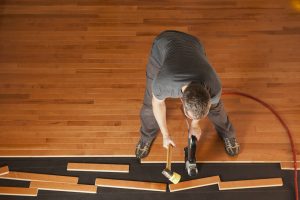
Installing new hardwood floors is something many homeowners dream of doing. Hardwood flooring remains the top style to strive for in the living room, dining room, and entryway. Simply put, there are few home improvement jobs that transform the entire house like hardwood flooring. The material provides warmth, beauty, and an elegant style that boosts property values and aesthetic.
Unfortunately, installing the new flooring can be tricky. Many homeowners are uncomfortable installing their own floors for fear of making a mistake. Your best bet is to hire an expert flooring provider for the installation.
First, here are a few tips you can try on your own if you’re not ready to hire help.
Choosing Your Floors
The first step in the installation process is choosing your new floors. With hardwood flooring, you have two main options: engineered wood flooring or solid wood flooring. Both offer unique benefits and drawbacks, which you should consider before making a decision.
Let’s start with engineered wood flooring, which is generally thinner than solid wood. It’s manufactured using a thin surface layer of hardwood and a strong, durable core made of plywood. If you’re planning on do-it-yourself installation, engineered is the way to go.
Solid wood flooring is the more traditional option. It is what most homeowners will strive for in the long run. Typically, solid wood is thicker than engineered, is cut from a single board of hardwood, and can be refinished multiple times. The downside, however, is that solid wood tends to warp, twist, or expand with moisture and humidity. It also usually needs to be installed by professionals.
Preparation
Installing new hardwood flooring is a big task. Therefore, it pays to ensure your results by preparing in advance. No matter the type of hardwood flooring you choose, you’ll want to ensure that your base is clean, smooth, and level before placing any floorboards. You could install the new wood over an existing floor for increased soundproofing and installation, thereby cutting out the removal process.
Hardwood Flooring Layout
With the previous floor and base prepared, it’s time to begin laying your hardwood flooring. You’ll need to know where the floor joists are located and install your new hardwood floors perpendicular to these joists. Start at the longest straight wall, which is generally an exterior wall, and work your way from there.
Most start with a 15-pound asphalt-laminated kraft paper underlayment as a vapor barrier and to soundproof the room. If you left the old floor in place, you can skip this step.
To ensure that no mistakes are made, you’ll need a few power tools. A power saw or table saw, for instance, will be used to cut down the boards into the proper shape. For irregular cuts, you’ll want a portable saber saw. Then, you’ll need a pneumatic floor nail gun to nail down each board. Without these tools, you cannot move forward.
You can skip all the frustration of DIY installation by calling Starwood Distributors at 214-718-7304. We provide expert hardwood flooring installation daily!










